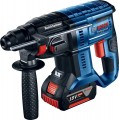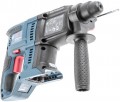Batteries in set
Most modern power tools use replaceable batteries, and then this paragraph indicates the number of such batteries. Such tools can be equipped with several batteries, usually
2 batteries(
models with 1 battery are not widely used).
In addition, quite a few modern cordless tools come in a configuration colloquially known as a “carcass” — namely,
no batteries at all. This option is relevant mainly for two cases: if the user wants to choose a power source separately, at his own discretion, or if such a source is already on the farm. Regarding the second option, it is worth noting that many large manufacturers use universal batteries suitable for different types of branded power tools. So a battery, for example, from a previously purchased jigsaw or grinder may well be compatible with a rotary hammer of the same company.
Battery type
The type of battery installed in the battery-powered tool (see "Power Source").
— Ni-Cd (nickel-cadmium). The most "old" option found in modern power tools. It is distinguished by high reliability, resistance to temperature extremes and good charging speed even with high capacity (which is important, given the "voracity" of the power tool). The main disadvantage of this type of batteries can be called a pronounced "memory effect" — a decrease in battery capacity if it is set for charging without being completely discharged. In addition, Ni-Cd cells are considered environmentally unsafe. Nevertheless, they are still widely used in tools — not least due to their low cost with decent performance.
— Ni-Mh (nickel-metal hydride). Such batteries were created as a development of the nickel-cadmium batteries described above. Retaining all the main advantages of their predecessors, they are at the same time devoid of most of the shortcomings — in particular, they are practically not subject to the memory effect. Of the own shortcomings of this option, it is worth mentioning a slightly lower durability and higher cost than the original Ni-Cd.
— Li-Ion (lithium-ion). A type of battery originally developed for use in portable devices; however, with the development of Li-Ion technology, it has also been used in power tools. The main advantage of such batteries in this case can be called a high capacity with small dimensions and weight. It is also worth noting...that they are not subject to the memory effect and are able to charge quite quickly. On the other hand, this option is not without its drawbacks — this is, first of all, sensitivity to too low or elevated temperatures, as well as a high price.
Battery capacity
The capacity of the battery that the tool is equipped with the appropriate type of power supply (see "Power Source").
Capacity is essentially the amount of energy a battery can store. The more powerful the device, the more energy it needs to work and the higher the battery capacity should be so that it does not have to be charged too often. At the same time, capacious batteries have a large weight and dimensions, which significantly affects the convenience of work. Therefore, the power of the cordless tool is relatively low — otherwise, too bulky batteries would have to be used.
To some extent, this parameter also determines the time that the tool is able to work without recharging. However, taking into account the fact that different models can differ markedly in power consumption, it makes sense to compare battery properties only with tools with very similar characteristics — and even then very approximately.
Note that the same tool can work with batteries of different capacities — it is enough that they are compatible in terms of connectors and operating voltage.
Charging time
The time required to fully charge the battery used in the tool using the standard charger.
For information on cordless tools in general, see “Power Source.” And charging time data allows you to estimate how you will have to organize your working hours and how long breaks you will need to charge your batteries. However, the specific meaning of this parameter also depends on the number of batteries included. Let us remind you that there are often several of them at once (see “Included battery”), and while one battery is working, the others can be charged. This allows you to reduce breaks to a minimum, or even do without them completely. But if there is only one battery, breaks for charging will inevitably be required in full, and
rotary hammers with fast battery charging will be very useful.
Charge level indicator
An indicator that indicates the battery level in the corresponding tool (see "Power supply"). This is advantageously achieved by means of an LED "light" which provides the simplest signals by changing colour and/or flashing frequency.
In box
-
Additional handle. The puncher has an additional front handle, usually located at the base of the cartridge. This handle can be non-removable or removable, rigidly fixed or movable. Holding with two hands for two handles is much more convenient than for one and the body, because. allows you to optimally distribute the load on the hands; this is especially important for long-term work and the processing of "heavy" materials.
-
Depth stop. A device that allows you to make recesses of a strictly defined depth at once, without constant measurements and without the risk of drilling deeper than necessary. It usually looks like a rod attached to the body of the puncher parallel to the working tool. In use, this rod extends to such a length that when the desired depth is reached, it rests on the surface of the material being processed, preventing the drill from moving further.
-
Chisel. Complete nozzle for impact work with a perforator in the manner of chasing, leveling hard surfaces, beating tiles, bricks, concrete, etc. For different tasks, various types of chisels are produced - flat, spade, groove, crushing peaks with a sharp tip.
—
Bur. The presence of a drill in the delivery set of a tool designed for processing various hard materials due to drilling with impact. The purchase of such a set eliminates the need
...to look for a drill separately, however, the characteristics of the complete nozzle must be clarified before purchase, because. they may not meet the requirements of the buyer.
- Charger. The presence of a charging unit in the configuration allows you to charge the batteries. Accordingly, for models with batteries, this accessory is necessary to power the battery. However, there are models without a charger. And punchers with it may differ in the model of the charger, the name of which will allow you to learn more about its characteristics and, if necessary or as needed (breakdown), buy a similar one.
- Case included. The presence of a special case in the delivery set, which facilitates storage and transportation: it provides protection against shocks and adverse conditions (moisture, frost), is equipped with a special carrying handle, in addition, along with the punch itself, a set of working tools can be placed in the case, replaceable cartridges, etc.
- Dust collector. The presence of a special dust collector in the delivery set of the perforator. As the name implies, it is designed to collect the dust generated during operation, which can otherwise create a significant inconvenience. Usually looks like a bag or container attached to the body; can be either replaceable (thrown away with the collected garbage) or permanent. The dust collector slightly increases the weight and dimensions of the puncher, however, if necessary, it can be removed.
